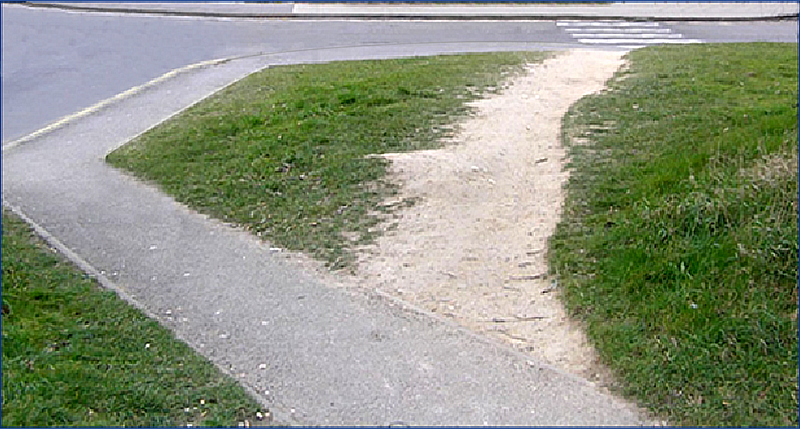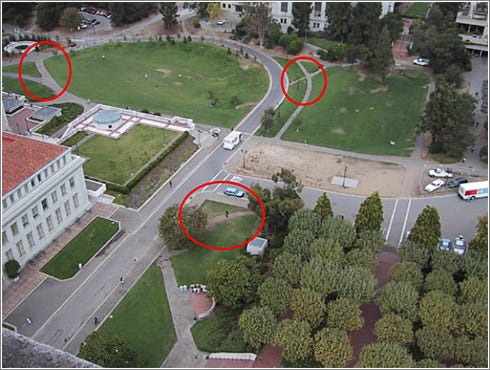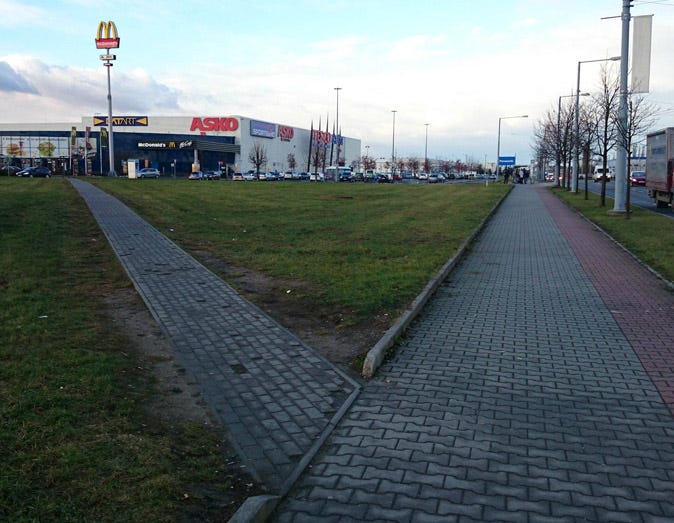tl;dr: How not to be a stubborn jerk when behaviors reveal user paths you didn’t initially anticipate.
User Story
As an end-user, I want the software to work for me; not the other way around.
Description
The internet is replete with images of inefficient park and greenway designs where users have beaten their own, more direct paths to where they wanted to go.
Why does this happen? Good question, but first a disclaimer: I’ve got no credentials as an architect or city planner, no do I play one on TV. That said, I’d bet my not-so-winning PowerBall ticket these instances of grass-smashing occur when the initial design doesn’t take into a variety of factors that are better visualized than described.
For example, below is an image courtesy of Matt Johnston, where it looks like the walkway was designed to follow the street versus offer the shortest distance between two points.
Here’s another offering from a 2003 post by Peter Merholz, which is followed by additional images of where landscapers constructed a barrier to the shortest distance in hopes of enforcing their envisioned design.
In the same blog post, we find yet more overhead images indicating the fence — sans enforcement of hungry Dobermans and/or tiger traps — did not stop students from simply stomping out yet another path.
Finally, we have an example via Austin Knight that demonstrates how allowing pedestrians to define the path to success in the short term contributed to better experiences for everyone in the long term.
UATs
So what does all this design stuff have to do with you and me as product managers? Glad you asked!
Over the past year, I’ve been looking for opportunities in my epics to integrate lean startup thinking into the agile process. This leads me to think that a ‘pedestrian path to data-driven design’ is yet another way we can collect data in our effort to deliver the right-sized feature set at the last responsible moment.
So here’s my theory, albeit a bit of a broad one.
- We believe we will increase greater user adoption if we know the actual path they’re taking through our software; implementing the efficient ones.
- If we continually adapt our workflow around data collected on behavioral flows, then we will see greater user success in accomplishing their tasks.
- We will know if we are right if periodic adjustments based on actual — and efficient — user paths lead to greater utilization and adoption of our applications, and a subsequent increase in workflow/task completion.
Like I said, a somewhat broad theory, but certainly measurable. Granted this one will take time, but I think it’s a worthwhile investment that will aid product managers in:
- understanding the user journey
- negotiating feature priority
- ensuring client retention
- reducing complexity
- aiding in application up-sells.
Bottom line is, as product managers we need to embrace the change users are telling us through their behaviors — at least the efficient ones — rather than sticking to initial designs based on emotion, assumptions, and/or convention.
At least that’s my theory, and I’m sticking with it until the data proves otherwise.
YMMV



